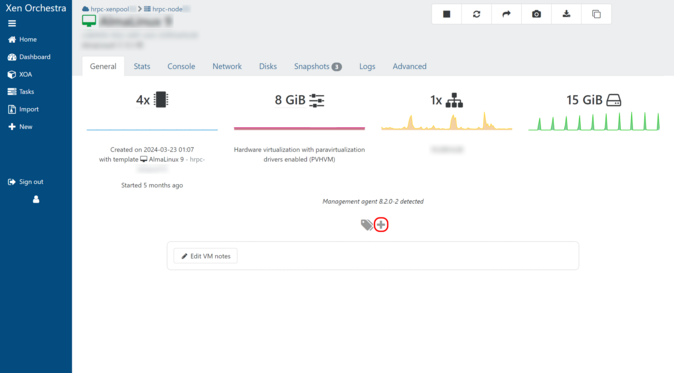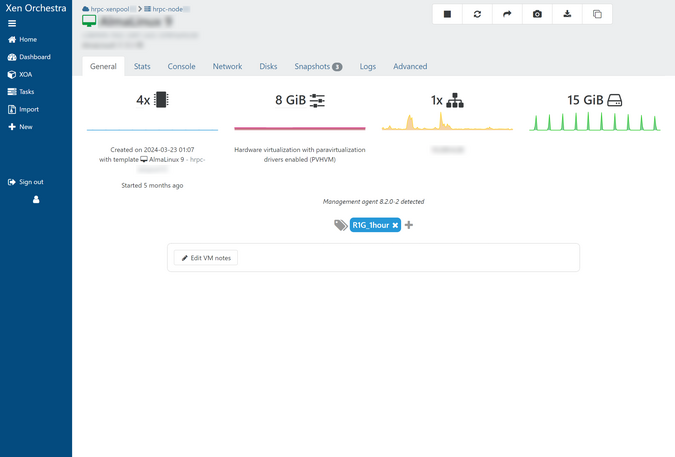
Back
Automatically Creating Periodic Snapshots
The rolling snapshot feature automatically creates snapshots on a planned basis and automatically deletes old snapshots whose remaining life has expired.
This function allows you to periodically preserve old virtual machine images at a certain point in time as snapshots (not backups).
By tagging a virtual machine with a specific tag, you can take regular snapshots. Please set it taking into consideration the timing of taking and deleting snapshots.
Note
- By taking a snapshot, the differential data area is secured. For details about the snapshot mechanism, see Support Information/Manuals/HRPC – Xen Orchestra/Virtual Machine Management/About Snapshots .
- Rolling snapshots only automatically delete snapshots that have expired, and there is no function to delete the oldest ones according to the free space. Please read Snapshots carefully and manage the free space appropriately. Also, depending on the number of snapshots taken and the frequency of data updates in the virtual machine, the size of the differential data may become large, which may affect the operation of all virtual machines that share the storage resource.
- If the timing of taking and deleting a snapshot overlaps, it may not be possible to take a snapshot at all. Therefore, be careful when using other mechanisms that use snapshots (such as Continuous Replication).
- For issues related to too many snapshots and deleting snapshots, see Support Information/Manuals/HRPC – Xen Orchestra/Managing Virtual Machines/Deleting Snapshots .
Procedure
1. Open the target virtual machine
From the list of virtual machines in HOME, open the virtual machine for which you want to take regular snapshots.
2. Tag it
Open the “General” tab and select the “+” next to the tag icon.

A tag input field will appear, so enter tags according to the conditions of the snapshot you want to obtain.
A snapshot of the VM’s disk (storage) will be created according to the tag rules you entered. The snapshot does not include memory (RAM), so the VM will not be paused or restarted.

Please refer to the table below for tag rules.
*Please note that if you enter a string that is different from the tag name, the snapshot will not be created.
| Tag Name | Retention Generation | Acquisition interval | Recovery Point Objective (RPO) |
|---|---|---|---|
| R1G_1hour | 1 | Every hour | 1 hour ago |
| R1G_3hours | 1 | 2,5,8,11,14,17,20,23 (hours) | 3 hours ago |
| R4G_6hours | 4 | 1,7,13,19 (hours) | Every 6 hours, up to 24 hours in advance |
| R6G_12hours | 6 | 3,15 (hours) | Every 12 hours up to 3 days in advance |
| R7G_24hours | 7 | 6pm | Every day up to one week before |
| R4G_1week | 4 | Sunday 9am | Every week up to 4 weeks in advance |
| R1G_1month | 1 | 0:00 on the 1st of every month | Every month, up to one month in advance |
If you set the tags “R1G_1hour”, “R1G_3hours”, “R4G_6hours”, “R6G_12hours”, and “R7G_24hours” simultaneously for one VM, the snapshot acquisition timing may overlap and snapshots may not be acquired correctly. Due to the structure of snapshots, multiple tag settings may cause unintended problems, so you need to pay close attention to the free space and acquisition status.
After entering the tag, press the Enter key to complete the tag setting.

A snapshot of the virtual machine is created in the Snapshots tab.

 Japan
Japan Korea
Korea China
China Taiwan
Taiwan Vietnam
Vietnam Thailand
Thailand Indonesia
Indonesia Portugal
Portugal Spain
Spain France
France Germany
Germany Egypt
Egypt Russia
Russia
